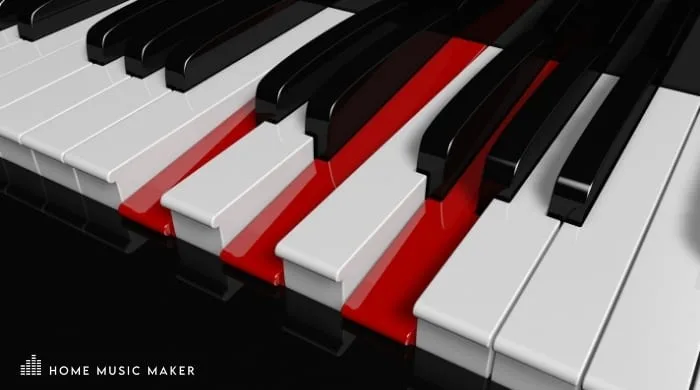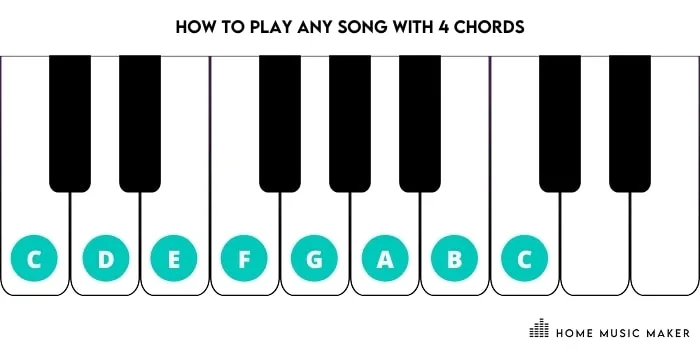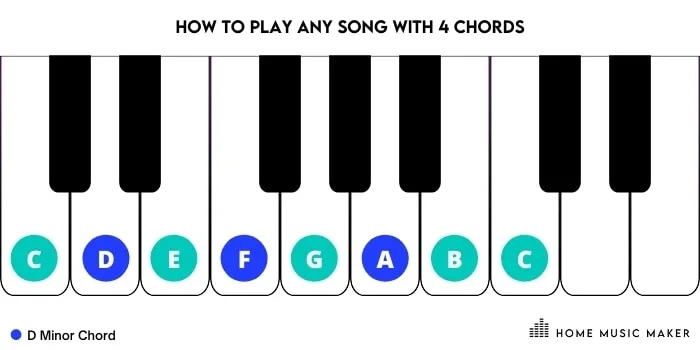As a new music producer or musician, the process of coming up with the perfect chords and chord progressions for a song can seem a little complex. It can be a bit overwhelming trying to figure out which chords will match a certain genre or which one’s fits an emotion perfectly. It’s even more intimidating when you don’t know how to make chords at all.
The great thing about chords is that you really only need to know four simple chords to produce a chart-topping pop song. That’s right; four commonly used chords have created thousands of chart-topping hit songs!
Playing a chord is simpler than it looks, and later in this article, I will explain how to do it step-by-step; but before then, let’s look at what chords are and how they should be used.
What Are Chords?
So, what are these popularly used chords? Before you can understand why they are so effective, you must first understand what a chord is. If you are new to music production or new to your instrument, you may not understand what a chord is and how it works.

A chord is a mixture of three or more notes that are played at the same time. Typically, if it’s three notes, it is called a triad. These chords are structured with a root note, which is the note chosen with the lowest pitch, and then the other two are chosen from a major or minor scale.
When musicians typically refer to chords, they use Roman numerals to name them. Understanding the basic knowledge of chords will help you understand why most songs use the same four-chord progressions.
What Are The Different Types Of Chords?
Several types of chords can create different elements and vibes in a song. These chords are called Major Chords, Minor Chords, Diminished Chords, and Augmented Chords. Major chords are often described as sounding complete, bright, and happy. It is the most common genre of chords, so much so that it is used to play Happy Birthday.

There are 12 major chords in all, all deriving from the 12 notes on a melodic scale. Minor chords are often described as sad or dark; however, there are some instances where minor chords can create a happier feeling, just like 12 major chords derive from the melodic scale.

Diminished chords are described as creating dark, tense, and dissonant sounds. They are created by adding a minor third note and the fifth note above the root note. When used as a guitar chord, they typically sound unstable or off-putting. There are three types of diminished chords in all.

Finally, augmented chords are described as odd and are rarely heard in popular songs. They are created by adding a raised fifth or better known as a sharp fifth. Due to their rareness, there are only four augmented chords in all.

What Are Chord Progressions?
Once you have figured out how to make the type of chord you want, you can begin to make chord progressions. Chord progressions are a series of chords, at least two or three, that help construct a piece of music. Chord progressions can be extremely simple or complex depending on the style of the song and music genre. Most pop records only consist of two simple chord progressions.
The Idea Behind Chords
Chords are the elements of the song that gives the emotion that the musician is aiming for. They captivate the listener’s emotion, but they also help differentiate the different sections of a song, such as the verse, chorus, and bridge. If you are playing the guitar, the chord’s emotion can be felt in the strumming pattern.

Musicians who play piano use chords to add different elements and tones to the chord progressions they create. Chords also help the singer or music producer create the song’s melody, whether created with guitars, ukuleles, or piano. Chords are also important because, depending on the strumming patterns or the melody’s pattern, they also articulate the song’s genre.
Putting Chords Into Songs
Chords are one of the main ingredients, and usually, the first element created when producing a song. As a beginner, whether you are playing guitar, piano, midi controller, or using the piano roll on a digital audio workstation, the process is a lot easier than it looks.
To make a major or minor chord, you must select three notes from a major or minor scale. These typically consist of the first, third, and fifth notes on a melodic scale.
Once you pick a note on the scale, you can move two steps up the scale until you reach the final one. For example, the D chord would be D, F#, A. Once you play all three of these notes together, they create a chord. There are several different types of chords that you can make as a musician that you can learn by studying music theory.

Is Music Theory Necessary
Speaking of theory, many music producers are often asked if music theory is essential to create a song. The answer to that is not necessarily.
As a musician, it would be helpful to know at least the basics of music theory, such as scales, key signatures, and chords, which we just gave a mini-lesson on above. However, to make simple guitar chords, piano chords, or the most commonly used four chords, you only need to know the basics of music theory to get started.
Some musicians create guitar and piano chords by trusting their ears. But, as a live musician, the theory may be more necessary to make sure your piano or guitar chords accurately accompany the vocalist or fellow musician.

The 4 Most Popular Chords
So now that you have a general understanding of what a chord is, you’re ready to find out which ones are the most common four-chord progressions used to make hit songs. The four main chord progressions used to make any music song are Roman numerals I, V, vi, and IV.
The chord progression chords are always from the C major, G major, A minor, and F major melodic scales. No matter how you flip this common chord progression, you will be able to find a hit song that stems from it. To see if this is true, you should take some time and listen to some of your favorite songs and apply this chord progression to the chords you hear.
C Major Piano Keys

G Major Piano Keys

A Minor Piano Keys

F Major Piano keys

Why Are These Chords So Common?
Since there are so many opportunities to make chords in music, you may wonder why these chords are so common. One of the main reasons is because they are easy to memorize.
Think about when you sit down to create something new or to practice; you typically start playing the notes you already know. Once you have those four main chords memorized, it’s easy to create something pleasing to the ear.
The average listener has also become accustomed to hearing those chord progressions, even if they don’t know what they are. Anything outside of those chord progressions will seem new and cool or new and odd to them.

You may be asking yourself, how can the same four chords produce so many different songs for so many years? Well, you wouldn’t be the first person to ask that question. Many musicians and producers often hit a wall wondering that same thing.
The great thing about music is that it has so many elements and layers beyond chords: several key signatures and eight octaves create the four chords and sound completely different from several others.
Different tempos or time signatures can make a song sound great for a mellow and laid-back vibe or make the song upbeat and just the right feel to turn up a party.
Different layers can dress up the four chords that can make them sort of fade in the background. For instance, certain rhythms can be the focal point of the song. This is heavily seen in hip-hop.

In other genres, the focal point of the song may be the melodies. Unique melodies can make a listener pay attention to the background’s chords, making them easy to use in many songs. Finally, the lyrics being added on top of the four chords can be an essential layer that makes one song different.
Other Chord Progressions
Although four-chord progressions are used in plenty of pop hits, musicians and producers can use other chord progressions to create songs.
Remember, you can choose your own chords to put into your songs and create a chord progression from there. It is a great way to spark creativity when you are experiencing a creative block.
For a song geared towards a sadder and depressing feel, musicians often use the F minor chord. Some musicians even try to get even more creative by using two chords in chord progressions.
Instruments That Play Chords
As a musician or music producer, you don’t have to limit yourself to a piano or guitar to create chords. If you are skilled in string instruments, you can create chords on violins, bases, electric guitars, harps, even a ukulele.
There are several types of pianos, xylophones, and other mallet percussion instruments that use scales to create chords for those who are good with keys. If you are a producer working in a DAW, there are countless options for different pianos and synthesizers to create chords and even blend chords with while creating chord progressions.
How To Play Any Song With 4 Chords
Step 1: Select a major scale to make the chords from. We will stick to the easiest chord, C Major, in all white notes for this example.
C D E F G A B C

Step 2: With chords, musicians use numbers to refer to the notes. These numbers correlate to the order the letters are in. For instance, C is 1, 2 is D, and 3 is E.

To build a chord, you have to start with a root note and then skip two steps to get to the next note of the chord until you get a three-note chord. It will look like this: 1-3-5

Step 3: Your C major chord should now be C-E-G. If you play all of those notes at one time, you will have played a chord.

Step 4: The second part of your chord progression will consist of the same process and a different chord from C Major. It will begin with the second note on the C Major Scale, which is D.
Step 5: Skip two steps and you will reach note F.
Step 6: Skip two more step two more steps and you will reach the chord A.
Your next chord in the chord progression should now be D-F-A.

Step 7: The third part of your chord progression will follow the same steps; only this time, you will begin on the letter E, the third note in the C Major Scale.
Step 8: Skip two steps and you will reach note G.
Step 9: Skip two more steps and you will reach note B.
Your next chord in the chord progression should now be E-G-B.

Step 10: Now that you get the hang of it, you can complete your chord progression with the fourth chord. It will begin with the note F from the C Major Scale.
Step 11: Skip two steps and you will reach note A.
Step 12: Skip two more steps and you will reach note C.
Your final chord in the chord progression will be F-A-C.

All four chords are now complete, and your four-chord chord progression will look like this:
I: C-E-G
V: D-F-A
vi: E-G-B
IV: F-A-C
Getting Better With Building Chords
Now that you understand what chords are and why they are important when creating a song, the next step is learning how to build them yourself.
It would be cliché to say practice, but it truly is the number one key to making your chords sound better. Over time, not only will you have the popular four-chord progressions memorized, but your ear will also be trained well enough to come up with chord progressions on your own.
Another way to get better is by listening for different chords and chord progressions in different songs while listening to the radio. If you play an instrument such as a guitar or piano, you already have an advantage to understanding how to make simple chords.
Common FAQ’s
What chords should I learn first?
Before you begin to learn any chord, you must first learn and memorize your major and minor scales. These are the notes that will create the chord. Most people memorize the chords first are the C major, G major, A minor, and F major chords.
How do you memorize guitar chords?
The best way to memorize guitar chords is by practicing. Practice the chord progression at least 20 times before moving on to another one. While practicing the chord, make sure that you are strumming the chord correctly to memorize the finger movement.
What is a three-chord?
A three chord functions as a weaker pre-dominant chord; it is also known as a mediant chord. It is important in a chord progression because it harmonizes the 7th chord as it blends into the melody.
What is a five-chord?
A five chord, also known as the power chord, is the 5th note from the root note in a chord progression. It is called a power chord because it is typically perfect in all triad, making it a dominant chord.
How many chords does a guitarist need to know?
The most common chords Most guitarists used in any genre G Major, C Major, and D Major.
What is the hardest guitar chord to play?
Without consistent practice, learning any guitar chord can be difficult. There are, however, a few guitar chords that even some of the most legendary guitarists have a hard time playing. They are a Cadd9 chord, Am9 chord, Badd9 chord, Cmaj9 chord, and B7add13.
How many chords should a pianist know?
There are 12 chords for a piano, and to be a master pianist, you should memorize all of them. However, most pianists only memorize the major chord for all 12 notes, making it easy to memorize. Again, if you are trying to create a hit song, you can memorize the main 4 mentioned above.
What is the hardest chord to play on the piano?
Unlike the guitar, the piano doesn’t have any common difficult chords. The chords that are always considered the easiest are the ones where they consist of all white keys. These chords come from the C major or A minor scale.
What is the happiest sounding chord?
Out of all of the chords in music, the happiest chord is the seventh chord. It is the happiest in both major and minor chords. When it comes to guitar players, the happiest chord is called the G major 13 chords, which Bach created.
What are some of the most popular songs with that main chord progressions?
There are thousands of major hit songs that use the main four chords, but a few popular ones are Lady Gaga’s “Poker Face,” Elton John’s “Can You Feel the Love Tonight,” Black Eye Peas’ “Where is the Love,” Bob Marley’s “No Woman No Cry,” and Michael Jackson’s “Man in the Mirror” to name a few.
Just like there thousands of hit pop songs that use the main four chord progressions. There are several chord progressions. Some popular songs using two chords are Etta James’ “I’d Rather Go Blind,” Alicia Keys’ “Fallin,” The Wailers’ “Lively Up Yourself,” B.B. King’s “When Love Comes To Town.”
If you want to hear some more, check out the excellent Axis Of Awesome below: (WARNING Contains Adult Language)
Final Words
The power of chords is not to be underestimated. As you’ve read above, pop songs have been made from only four simple chords since the charts began. Certainly, the right chord can make all the difference in a song’s success and popularity with listeners. With just 4 easy chords on your guitar or keyboard, you’ll soon find yourself well on your way to creating music that resonates with people everywhere!



 Want to connect with other music producers for help and guidance?
Want to connect with other music producers for help and guidance?